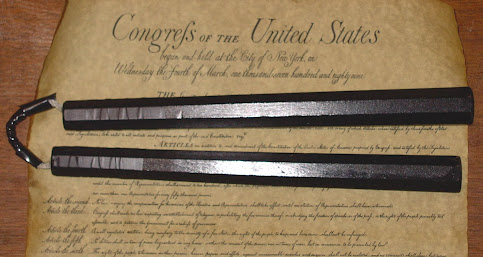Dangerous instrumentality, ineffective weapon , or wise compromise?
The nunchaku is perceived radically differently among different people. To some, like Richard Ross, the New York Assemblyman who introduced the total ban, it was perceived as nothing other than an instrument of mayhem and murder with “no purpose other than to maim, or in some instances, kill.” To others, such as the judges of the Supreme Court of Hawaii in State v. Muliufi, 64 Haw. 485, 643 P.2d 546 (1982), “nunchaku sticks, as used in the martial arts, are socially acceptable and lawful ... especially here in Hawaii where the oriental culture and heritage play a very important role in society.”
To the casual reader of page 51 (“CLINICAL NOTES”) from the January 1988 issue of the medical journal Clinical Pediatrics (click displayed image for access to article online), a nunchaku would seem to have once been the cause of a skull fracture in a 10-month-old girl. But on closer reading, it becomes clear that the girl actually fractured her skull by falling and hitting a hardwood floor. While it is true that she fell because she was hit in the face by one stick that had come flying away from a homemade nunchaku that had been in the hands of her 11-year-old brother, that blow caused only swelling and a contusion. More to the point, any flying object--a ball, a frisbee, a champagne cork, etc.--could just as easily cause a 10-month-old standing on a hard surface to fall and sustain a head injury in the process. To blame the nunchaku, rather than the brother or even to some extent the parent(s), would make no sense, but the one-page article prudently concludes with warnings as to the capability of the weapon in expert hands and the possibility of its being overlooked as a potential danger in the hands of the untrained.
“Urban legends” persist that when these “deadly sticks” are being swung around, bones (including skulls) can be fractured with ease, even accidentally. The false underlying premise is that the centrifugal force generated is so great that the swinging stick will shatter or demolish any object it hits. In truth, unless certain nuances of striking are learned, the stick will much more readily tend to bounce or recoil off hard objects like bones.
Although not as effective for offensive purposes as a baseball bat, the nunchaku is well-suited for non-lethal defensive purposes, particularly against unarmed attackers or those with edged weapons. As I explained to the District Court in a brief in 2006, burglars and other persons illegally entering homes commonly attack the occupants with knives, either brought in from outside or obtained from within the victims’ own homes (typically the kitchen). The late George Harrison of The Beatles was stabbed several times (including one chest wound that collapsed a lung) in 1999 by one such intruder/assailant, Michael Abram, who invaded the Harrisons’ home. But the odds of that happening to me are pretty slim, and having a loaded firearm next to my bed, with all the risks that entails, isn’t really called for. I’d sleep a bit easier if I were allowed to have a pair of nunchaku tucked under my mattress so that I’d have a better fighting chance if I were to wake up in the middle of the night to the sound of an intruder. An important further advantage from a humanitarian perspective is that the use of nunchaku would permit self-defense without resort to lethal force. (It should be borne in mind that many home invasions are committed by mentally ill persons who would not necessarily be intimated by a loaded gun but who certainly do not deserve to die as a consequence of their disease.)









